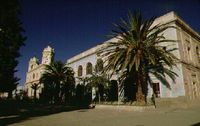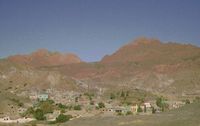A city surrounded by canyons
 Tupiza
Tupiza ![]() is a pleasant little town of 20,000 inhabitants
located 100 km from the border with Argentina in the Río Tupiza valley. At 2,950 meters above sea level,
the city enjoys a mild and sunny climate throughout the year.
is a pleasant little town of 20,000 inhabitants
located 100 km from the border with Argentina in the Río Tupiza valley. At 2,950 meters above sea level,
the city enjoys a mild and sunny climate throughout the year.
 One can spend some time admiring a few monuments and
churches from the colonial period, resting for a while in the central park, or sauntering inside the market.
However, the real attraction of the region is certainly the surrounding landscape of the cordillera of Chichas
with its colorful hills and canyons.
One can spend some time admiring a few monuments and
churches from the colonial period, resting for a while in the central park, or sauntering inside the market.
However, the real attraction of the region is certainly the surrounding landscape of the cordillera of Chichas
with its colorful hills and canyons.
Tupiza mines
Tupiza's economy centers on agriculture and mining (antimony, lead, silver and tin).
At the beginning of the XXth century, the city was home to the largest mining companies in southern Bolivia.
In 1906, after numerous bank robberies and attacks on trains in several South American countries, Butch Cassidy and Sundance Kid (two famous North American outlaws with the dubious distinction of having committed the longest series of robberies) entered Bolivian territory and settled in the Tupiza region. For several months, the two men worked "honestly" in the tin mines of Concordia.
In 1908, the Cassidy-Sundance duo stole money from the Aramayo tin mine. This was their last act of robbery. According to history, it is believed that during their escape Sundance and Cassidy were shot dead by Bolivian soldiers in San Vincente (a mining city near Tupiza).
Historical milestones
- The Tupiza region was originally populated with Aymaras Chichas.
- The Chichas community lost its identity after the annexation of the southern territories of Bolivia by the Inca empire in the XVth century.
- In the XVIth century, the area was occupied by the Spanish, initially attracted by the pleasant climate and the agricultural resources of the area, then by the mining richness of the Chichas cordillera.
- Tupiza was founded in 1574.
- 1781 peasant rebellion crushed by the Spaniards.
- 1810 Suipacha battle: first battle in Alto Peru for independence, with Argentine troops victorious against the Spaniards.
- 1825 Tumusla battle: After the glorious victory at Ayacucho, General Sucre was sent to Alto Peru by Simon Bolívar and won a new decisive battle for independence. The Spanish royalist troops capitulated.
- A few months later, Bolivian independence is proclaimed in the town of Sucre.

